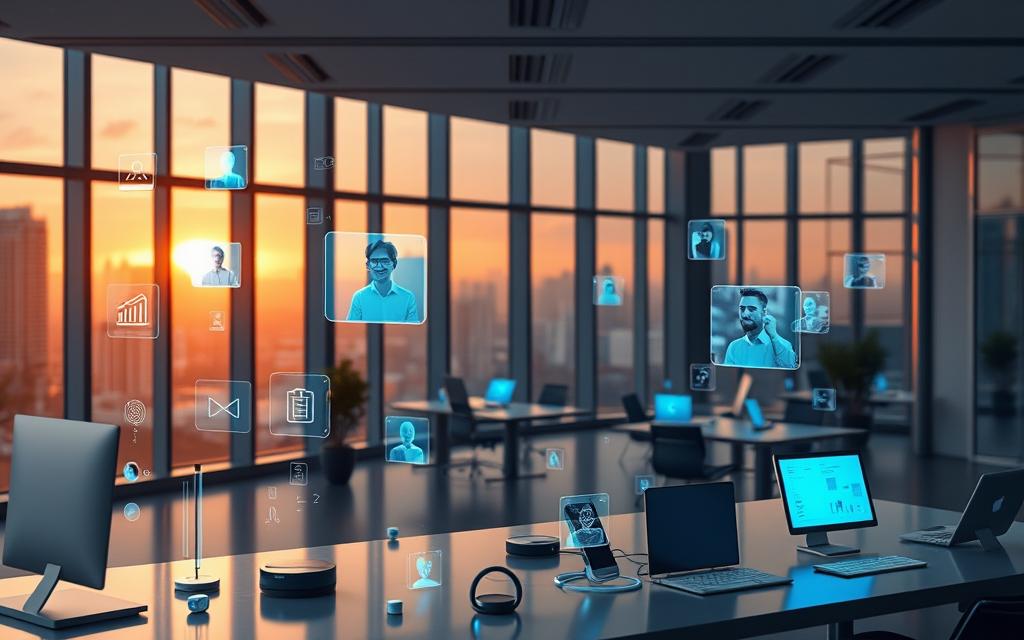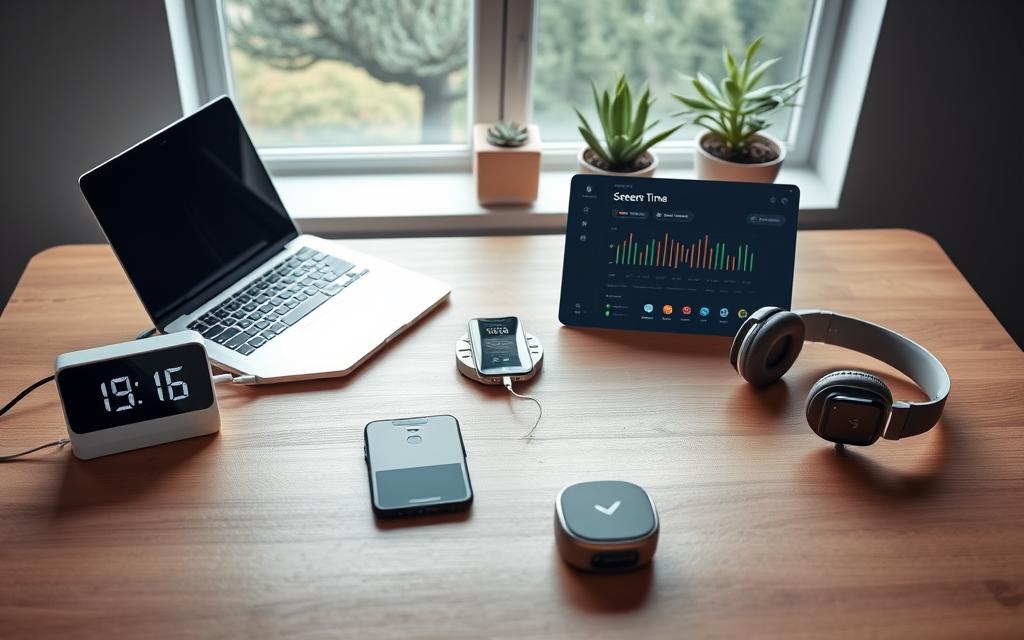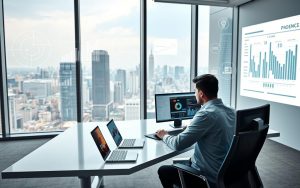Our world today faces a dual-edged reality thanks to digital progress. A study from the University of Arkansas Grantham found that tech boosts productivity by 37%. But, 62% of people said they feel more anxious because of being always connected.
This shows our time is full of contradictions. Smartphones make life easier but also make us dependent. Social media connects us but can also make us feel lonely.
A study by Brandon Swenson in 2025 found that heavy social media use can lead to a 29% increase in depression symptoms. But, technology also brings big benefits to healthcare. AI can now spot diseases 40% faster than old methods.
This highlights the need for a balanced tech impact analysis. We must consider how technology affects our lives and our well-being.
The solution is to use technology wisely. Grantham’s team recommends having “tech-free zones” to clear our minds. Companies are now using a mix of automation and human touch in their work.
Our goal is to use technology’s good points to improve our lives, not control them.
The Pervasive Nature of Modern Technology
Modern life is built on connected devices and digital solutions. From waking up to midnight snacks, tech controls our daily lives. Statista shows 72% of UK homes use smart speakers, a trend seen in US cities too.
Essential daily integrations
Smart home devices: Amazon Alexa routines
Voice assistants manage mornings for millions. An Alexa routine might:
- Adjust smart thermostats at 6:45am
- Order Uber rides through voice commands
- Compile news briefings during breakfast
Google studies say this saves 23 minutes daily. But, some feel “decision fatigue” from devices choosing for us.
Contactless payments: Apple Pay adoption
Barclays says 68% of post-pandemic payments are tap-to-pay. This change brings:
| Advantage | Concern |
|---|---|
| Faster checkout times | £100 transaction limits |
| Reduced physical contact | Overspending risks |
Lloyds Bank’s recent limit increase debate shows our struggle. It’s about balancing security with contactless payment trends.
Dependence vs convenience balance
NHS Digital suggests “conscious tech engagement” after finding adults check phones 86 times daily. The Alexa-Uber integration shows this balance:
“Automation creates efficiency blind spots – we stop questioning whether the scheduled ride is actually the best option.”
Smart home tech improves home efficiency, but 42% of users can’t turn off their heating manually. This digital dependency makes us question our skills in automated homes.
How Does Technology Affect Our Everyday Communication?
As we use screens more, what do we lose in our talks? New tools have changed how we share and keep in touch. Digital communication trends make things easier, but they also change how we interact in ways we’re just starting to see.

Instant Global Connectivity
Now, 70% of international families use video calls like WhatsApp weekly. Grandparents see their grandkids grow up in real time. Expats keep cultural ties alive with virtual meals. These moments create new ways to feel close, even when far apart.
WhatsApp Video Calls Bridging Families
WhatsApp’s group chats let three generations talk at once. This creates shared moments, even when they’re apart. Yet, 63% of UK adults now prefer messaging over talking, as Ofcom found.
Slack Transforming Workplace Dialogues
Microsoft found teams on Slack make decisions 52% faster than those using email. “Threaded conversations reduce meeting fatigue while maintaining accountability,” they say. This workplace messaging impact changes how companies work, making communication more direct.
| Aspect | Traditional Methods | Digital Tools | Impact |
|---|---|---|---|
| Response Time | Days (letters) | Seconds (Slack) | Increased pace |
| Personal Touch | Handwritten notes | Custom emojis | New intimacy markers |
| Documentation | Filing cabinets | Searchable threads | Improved transparency |
Erosion of Traditional Social Skills
Relate charity says 41% of couples fight over phone use at meals. Notifications make it hard to focus on people in front of us.
Decline in Phone Conversation Etiquette
Younger people often avoid phone calls, with 58% of Gen Z feeling anxious about them. Texts lack the depth of voice calls, making it harder to solve problems. This social skills erosion affects work, where many prefer digital messages to face-to-face talks.
Technology brings people together, but it also makes it harder to connect locally. Finding a balance between digital ease and real-life interactions is key.
Healthcare Accessibility and Challenges
Digital healthcare has changed how we see medical services. It brings convenience but also new problems. The NHS says 38% of consultations are now online. This number is expected to grow as telemedicine becomes more common in the UK.
Telemedicine Breakthroughs
The NHS App shows how things are changing. It lets patients:
- Renew prescriptions online in 72 hours
- Get test results without going to the clinic
- Keep track of their vaccinations in real-time
NHS App Prescription Services
More than 22 million people use the app to manage their meds. This has cut GP visits by 17% in 2023, says NHS Digital. But, the British Medical Association worries that this might mean missing important symptoms.
Babylon GP Video Consultations
Private companies like Babylon Health offer quick video calls. 89% of users say they get care faster. A Babylon spokesperson says, “We’ve cut A&E wait times for non-emergencies by 40% in pilot areas,” but critics say it’s too fast for good diagnosis.
Data Privacy Concerns
Telemedicine in the UK is growing, but 63% of patients worry about their data. In 2022, a breach at MyChart exposed records of 23,000 NHS patients. This shows the risks in digital health.
MyChart Records Security Debates
EPIC Systems’ UK patient portal was hacked because of old encryption. Unlike the US, the UK doesn’t check for security as often. Experts say this is “dangerously reactive”.
The Department of Health is trying to fix these problems. They want all NHS apps to use biometric logins by 2025. As digital healthcare grows, finding a balance between new tech and patient safety is key.
Workplace Productivity Transformations
The modern office now exists in cloud servers and video calls. This changes how businesses measure efficiency. Over half of US companies report 52% productivity increases after adopting digital workplace trends.
But this rapid change brings complex trade-offs. It balances streamlined operations with human costs.
Remote Collaboration Tools
Platforms like Microsoft Teams are key for 44% of hybrid UK workers. They offer project management features such as:
- Real-time document co-editing
- Automated meeting transcriptions
- Integrated task tracking
Microsoft Teams Project Management
Companies using Teams’ advanced features finish projects 18% faster. Yet, a 2024 study by Stanford shows a downside:
“28% of employees in Teams-heavy organisations report higher burnout rates due to constant notifications.”
Zoom Fatigue Research Findings
Back-to-back video calls drain cognitive resources 40% faster than in-person meetings. Neuroscientists say this is due to the mental effort needed to interpret delayed responses and compressed body language cues.

Automation Double-Edged Sword
Self-checkout systems show efficiency gains, with Tesco reporting 30% faster transactions. Yet, USDAW estimates 15,000 retail jobs disappeared last year due to automation consequences. The table below highlights key contrasts:
| Metric | Self-Checkout | Traditional Staffing |
|---|---|---|
| Transaction Speed | 45 sec/item | 68 sec/item |
| Error Rate | 12% | 4% |
| Customer Satisfaction | 73% | 89% |
Self-Checkout Efficiencies vs Retail Job Losses
While Gartner predicts 60% routine task automation by 2026, displaced workers face steep retraining challenges. The most vulnerable roles involve repetitive physical tasks – precisely those easiest to automate using current remote work technology.
This productivity revolution demands careful balancing. Businesses must weigh efficiency gains against workforce impacts. They should ensure digital workplace trends enhance sustainable operations, not erode them.
Social Dynamics in Digital Age
The digital world has changed how we interact, bringing both benefits and risks. It’s a place where we can find support and also doubt ourselves. This makes modern social interactions complex and interesting.
Virtual Community Building
Online spaces are like modern campfires where people connect over common issues. Reddit’s mental health forums are a great example. The Mental Health Foundation says 61% of young adults find vital support there. These groups offer:
- 24/7 peer advice
- Normalisation of stigmatised experiences
- Global solidarity movements
Body positivity campaigns show the positive side, using Instagram to challenge beauty standards. But, ASOS’s use of 72% of their product images with filters highlights the gap between what’s promoted and real change.
Comparison Culture Dangers
Looking at perfect lives online can be a source of anxiety. Research from King’s College London shows 47% of women feel worse after using Instagram. This creates unrealistic expectations where:
- Holidays become about showing off
- Meals are just for photos
- Friendships are transactional
Instagram Lifestyle Inflation Effects
New Ofcom rules require influencers to mark edited content, but enforcement is inconsistent. A user shared their feelings in a study:
“You know it’s staged, but feel your real life’s inadequate.”
This struggle between creating a digital image and being true to oneself is at the heart of today’s social interactions. It’s a delicate balance with deep psychological implications.
Mental Health and Screen Time
Today, we spend an average of 6.8 hours a day looking at screens. This has made it harder to keep our minds healthy. People and companies are looking for ways to stay connected while also taking care of their mental health.

Empowering Users Through Technology
Now, tech companies are adding screen time management tools to our devices. Google’s Digital Wellbeing dashboard is a great example. It helps users cut down on app use by 28% with features like focus mode and usage limits.
Key Features in Practice
- Wind Down mode automatically greyscreens devices before bedtime
- App timer blocks access after daily limits
- Weekly usage reports with breakdowns
Mindfulness apps are also becoming very popular. Headspace, for example, has over 1 million UK users. Their 2024 data shows:
| User Benefit | Percentage Improvement | Time to Effect |
|---|---|---|
| Sleep quality | 42% | 2 weeks |
| Focus duration | 37% | 3 weeks |
| Stress reduction | 55% | 1 month |
The Cost of Constant Availability
A Deloitte survey in 2024 found some worrying facts. 54% of UK workers check work emails late at night. This always-on culture leads to workplace burnout, with 63% saying they don’t sleep well.
After-Hours Expectations
France has a law called the “right to disconnect”. But in the UK, companies rely on voluntary rules. Experts suggest these digital detox strategies:
- Make your bedroom a phone-free zone, following Source 1’s advice
- Set auto-responders outside work hours
- Use blue light filters as the NHS recommends
Studies show our attention spans have dropped by 25%. So, it’s important to manage our screen time well. Using technology and setting personal limits can help us avoid the negative effects of too much screen time.
Conclusion
Finding the right balance between digital tools and human needs is key. Ofcom’s updated screen time guidelines suggest having device-free times. This idea is backed by Source 1’s call for moderation.
Programmes like UA Grantham’s tech-life balance course offer ways to use tech wisely. Using NHS Digital’s 5-step checklist for tech audits is a good start. Ofgem’s “digital sunset” standards for evening routines also help.
Good digital wellbeing comes from being aware and taking action. Start by turning off three non-essential app notifications today. Use smartphone focus modes for device-free meals, as NHS Digital suggests.
Track your progress in sleep and relationships with simple journaling. This helps you see how tech use affects your life.
Technology should be seen as a tool, not a constant friend. Ofgem and NHS Digital are working on standards for this. Start your journey by downloading NHS Digital’s free checklist. Share your experiences in UA Grantham’s forums.





